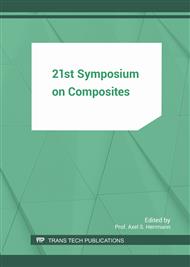p.520
p.527
p.535
p.544
p.555
p.562
p.568
p.576
p.583
Development of Nonwoven Preforms Made of Pure Recycled Carbon Fibres (rCF) for Applications of Composite Materials
Abstract:
For the development of an efficient and economic recycling process of carbon fibers (CF) still many technological challenges have to be mastered. One of them is the removal of all extraneous natural and synthetic fibres, e.g. polyester sewing threads. The objective of the research was to develop an in-line process for the removal of those extraneous fibres, which result from mechanical processes such as tearing. A promising approach for the removal of extraneous fibres from cut-off carbon-fibre material (CF) has been identified, getting recycled carbon fibres (rCF). For that purpose, the use of modern laser technologies is particularly promising. However, the focus was not the development of new laser systems, but the adaptation of existing technologies and their integration into textile processing steps for carbon fibre recycling. In addition to the removal of the extraneous fibres, the degree of CF losses and quality degradation due to fibre damage have been analysed and compared with optimum fibre characteristics. The separation has been experimented and corresponding laser parameters have been defined. Finally, the obtained carbon-fibre material has been tested with regard to its processability in textile manufacturing processes (dry non-woven fabric production) up to carbon fibre reinforced plastics (CFRP). For the evaluation of the material for potential applications, test plates from irradiated and non-irradiated material have been used. The performed tensile and flexural tests have proved that the irradiated material has similar properties compared to the non-exposed one.
Info:
Periodical:
Pages:
555-561
Citation:
Online since:
July 2017
Authors:
Price:
Сopyright:
© 2017 Trans Tech Publications Ltd. All Rights Reserved
Share:
Citation:


